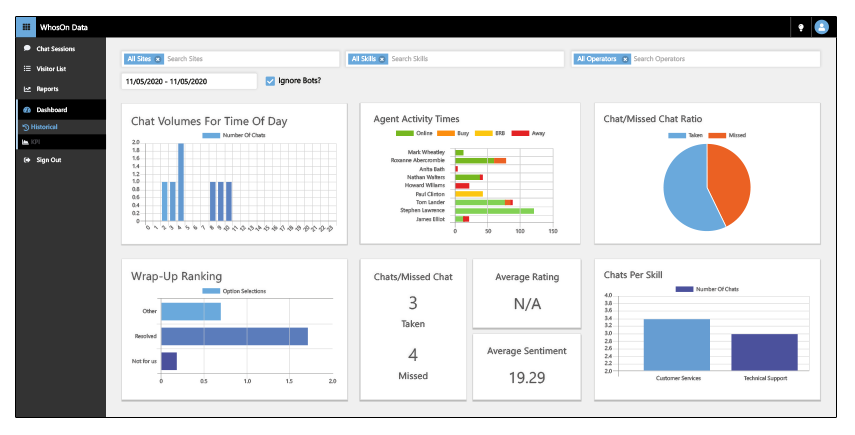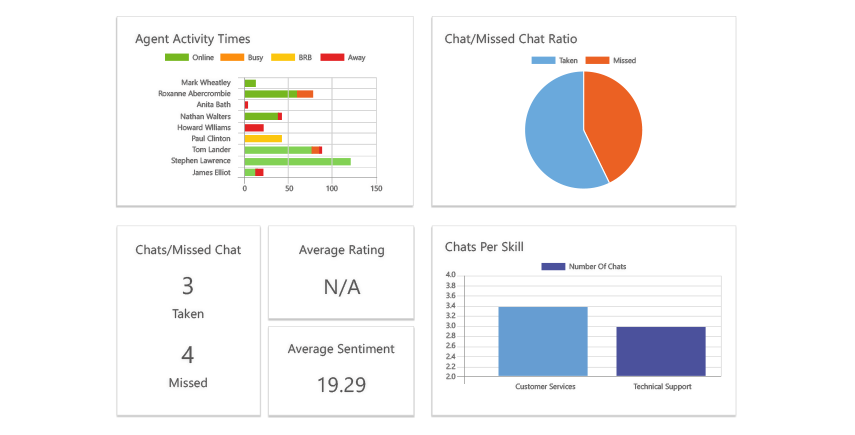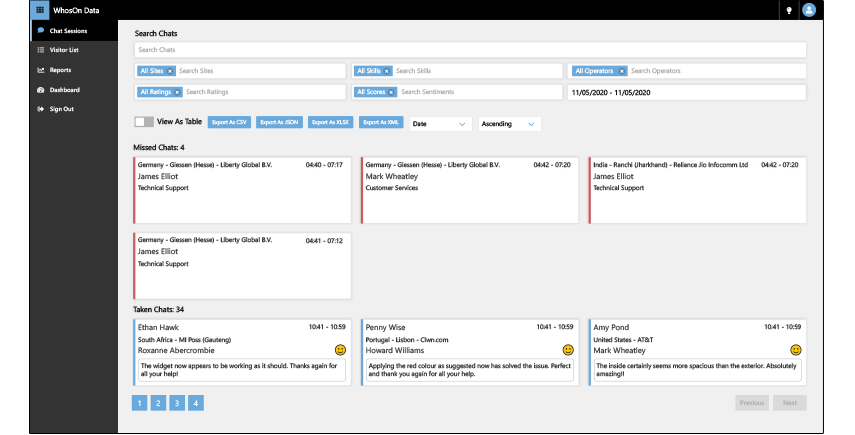How do you know if your live chat channel is working effectively? Deploying chat is a strong step forwards in terms of customer satisfaction and digital transformation, but it’s only the first step.
To continually improve your chat support, you need to measure its performance. (And the performance of the agents manning the channel.)
Enter live chat KPIs.
Tracking KPIs helps you tune chat over time and make sure you’re getting the most from its deployment.
But with so many different possible metrics to choose from, it’s hard to know where to start. So, which chat KPIs should you monitor?

A glimpse inside live chat metrics via WhosOn 
Operator KPI dashboards
Chat volume
An obvious place to start with chat KPIs is volume. That is, metrics that show how your customers engage with the chat channel.
Chat volume metrics give you a starting point to ensuring you have enough agents manning the service.
Plus, they help you build a picture of how much your chat channel means to your overall service offering.
1. Chat engagement
Measuring chat engagement is the first step to making sure you (and your customers) are getting the most out of your chat channel. To measure, look at the percentage of your website visitors that connect to chat.
A low percentage could mean that your chat button is hard to find. Or it might suggest that you need to make better use of proactive chat invitations. A high percentage, meanwhile, demonstrates that chat is popular with your customers.
2. Number of chats per day
There are two chat KPIs to manage here. The first is the average number of chats your team takes overall per day. This can help you to plan team numbers and understand roughly how many chats an agent is likely to handle per day.
The second is the number of chats an individual agent takes on. This offers a baseline to understanding how efficient an agent is.
Note: this alone is not the best metric for performance, as there may be reasons behind an agent taking fewer chats in one day. (For instance, they handle trickier, second-line support chats.)
3. Number of missed chats
A missed chat represents a missed opportunity; a customer that’s fallen through the cracks. So, monitoring missed chats as one of your chat KPIs helps identify incongruencies between customer service supply and demand.
By monitoring missed chats, you can adjust agent numbers where needed. It can also help you spot patterns and get an idea of agents that might need extra support. (I.e. we miss more chats when agent Y is working.)
Agent monitoring
Naturally, many of your chat KPIs will apply to individual agents. These KPIs show you how individuals are performing, and where they may need extra help, extra hands, or extra training.
4. Number of chat transfers
Chat transfers are a handy tool — great for letting teams support each other and ensuring customers reach the best person. But they should be a last resort — and a semi-rare occurrence.
A high number of chat transfers between all your agents tells you that you need more robust chat routing rules. A high number of chat transfers from one agent, meanwhile, could indicate that the agent needs more support or training.
5. Average chat handle time
Average chat handle time is another of the chat KPIs that helps you gauge the efficiency and effectiveness of agents. It also helps you plan how many agents you need at a given time or day.
You take the average because some chats will take longer than others, by nature of the issues addressed. It’s also worth factoring in departmental differences. Chat handling times will likely be longer in technical support, for example.

A live chat report sample 
Sample data from chat sessions
Queue management
When it comes to live chat, it’s key that you live up to the live promise. As such, metrics around wait times make up more of the best chat KPIs to monitor.
6. Average queue time
Customers don’t expect to wait for a ‘live’ chat session. So, you need to ensure that you aren’t leaving them in long queues. (In fact, this is a major pitfall when it comes to using a chat channel.) Long wait times lower customer satisfaction.
By measuring your average chat queue time, you can spot the times and seasons where you need more (or fewer) agents.
7. Queue abandonment rate
Queue abandonment rate is a simple way to gauge how long your customers are willing to wait before giving up.
If your abandonment rate is high, you may need to adjust your queue rules and messages to better manage expectations. That could include marking chat as offline if X visitors are waiting to chat, for example.
Customer experience
Finally, you should monitor the chat KPIs that surround the customer’s experience and impression. These metrics give you an idea of the quality of service that your agents offer. Capable, empathetic agents will make for happy, satisfied customers.
8. Sentiment scores
People will remember how you made them feel. So, it stands to reason that the sentiment behind the chat — how the customer appeared to feel — forms another of the integral chat KPIs.
Sentiment scores give you an overview of the customer’s mood. So, the better the agent makes them feel, the higher the score, and the happier the customer, to boot. With this information, you can see where agents are excelling with their empathetic responses. (And potentially driving customer loyalty.)
9. First contact resolution
Your customers connect to the chat to achieve something. So, another of the key chat KPIs is one that looks at how often an agent can solve customer issues in a single chat interaction. You can measure this by looking at the number of tickets created, and also by analysing answers from post-chat surveys.
Some issues take time or specialised expertise to solve. If you have a high number of chats requiring customers to come back, it can highlight problems that aren’t suited to the channel, or areas where agents need more training.
10. Conversion rate
If you’re using chat as a sales tool, conversion rate is another of the most useful chat KPIs to monitor.
Conversion rate tells you how effective the efforts of your agents are. This can help you identify agents that need more training, or even practices that one agent does that are effective.
Chat KPIs
These are not the only chat KPIs you can monitor. There are plenty more, from the number of escalations to the number of concurrent chats that each agent can take.
Then, there are industry specific KPIs to consider. An insurance company might set a KPI around compliance and DPA, for instance.
A public sector organisation offering an array of services may wish to track chat tags, to better understand the most common queries coming into chat.
But these ten chat KPIs are the ones that you should definitely find space for. They offer a great starting point to ensuring the effectiveness of both your chat channel and the agents behind it.


